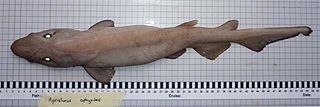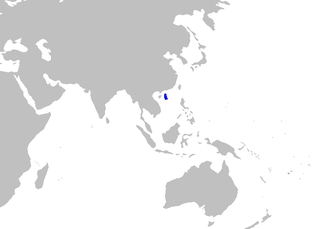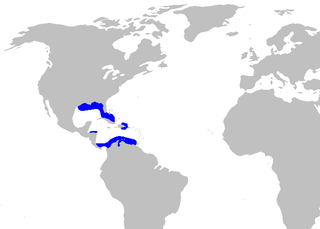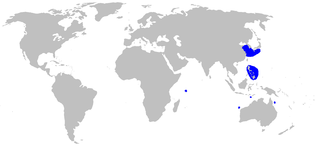
Catsharks are ground sharks of the family Scyliorhinidae. They are the largest family of sharks with around 160 species placed in 17 genera. Although they are generally known as catsharks, some species can also be called dogfish due to previous naming. However, a dogfish may generally be distinguished from a catshark as catsharks lay eggs while dogfish have live young. Like most bottom feeders, catsharks feed on benthic invertebrates and smaller fish. They are not harmful to humans. The family is paraphyletic, containing several distinct lineages that do not form a monophyletic group.
Kazuhiro Nakaya is a Japanese marine scientist and ichthyologist. He graduated from Hokkaido University with a BA in 1968 and with a PhD in 1972. He is professor of Marine Environment and Resources at the Marine Laboratory for Biodiversity. He specializes in taxonomy and evolution of sharks, rays, chimaeras, and Lake Tanganyikan fish. He is the author of many articles and books on sharks and fish. In 1995 he was put in charge of dissecting and preparing the 7th specimen of the very rare megamouth shark.

Apristurus is a genus of catsharks, the family Pentanchidae, the deepwater catsharks. The species in this genus are commonly known as the ghost or demon catsharks.

Galeus is a genus of catshark, belonging to the family Scyliorhinidae, commonly known as sawtail catsharks in reference to a distinctive saw-toothed crest of enlarged dermal denticles, found along the upper edges of their caudal fins. They are found in the Atlantic, the western and central Pacific, and the Gulf of California, inhabiting deep waters at or close to the sea floor. Members of this genus are rather small, slim sharks with firm bodies and thick, rough skin. Their heads are usually fairly long and pointed, and have large mouths with well-developed furrows at the corners. They have large pectoral and anal fins, and two similar dorsal fins placed well back. Many species are ornately patterned with dark saddles and/or blotches. Sawtail catsharks feed on various invertebrates and fishes, and may be either egg-laying or live-bearing. These harmless sharks are sometimes caught as bycatch but are of minimal commercial value.

The humpback cat shark is a shark of the family Pentanchidae, the deepwater catsharks, in the order Carcharhiniformes, found in the northwest Pacific Ocean off Zhujiang, South China Sea, from the surface to 915 m. Its length is 39–41 cm. The largest specimen examined by Nakaya and Sato was 54.2 cm TL. The humpback catshark is a little-known oviparous deepwater catshark.

The mouse catshark is a species of catshark and part of the family Scyliorhinidae. It is common in the northeastern Atlantic Ocean from Iceland to Western Sahara. There is much taxonomic confusion regarding this species in Icelandic waters, where it may be confounded with another species of Galeus or Apristurus. Probably not exceeding 49 cm (19 in) long, the mouse catshark has a uniformly brown body and is characterized by large, rounded pelvic fins and crests of enlarged dermal denticles along both the dorsal and ventral caudal fin margins. In addition, in adult males the inner margins of the pelvic fins are merged into an "apron".

The white ghost catshark is a shark of the catshark family Pentanchidae, the deepwater catsharks. This shark is found in deep water in the northeast Atlantic between latitudes 57°N and 58°N. A deep-water catshark known from the eastern North Atlantic from depths of 1,014 to 1,800 m, it is known from only a limited number of specimens. It reaches a maximum of 54 cm or 1.7 ft total length which is a medium size for the Apristurus genus.

The smallbelly catshark is a shark of the family Pentanchidae, the deepwater catsharks. This species is found in the western Indian Ocean near Somalia, the Gulf of Aden, and Oman, at depths between 1,300 and 1,840 m. Its length is up to 34 cm, although this measurement is of an immature specimen. The smallbelly catshark is not well known. It is found on continental slopes, and is probably caught by bottom trawlers. The reproduction of the smallbelly catshark is oviparous.

The shortnose demon catshark is a shark of the family Pentanchidae, the deepwater catsharks. This species is found only in deep water in the East China Sea. Its length is up to 40 cm. A. internatus is known only from the holotype and a paratype, both caught in the East China Sea, probably taken as bycatch in deepwater trawl fisheries. The reproduction of this catshark is oviparous.

The Iceland or Icelandic catshark is a species of shark, belonging to the family Pentanchidae, the deepwater catsharks. This catshark is found in the western Atlantic, from Massachusetts, Delaware, and the northern Gulf of Mexico, as well as the eastern Atlantic from Iceland, southwestern Ireland, the Canary Islands, Madeira, South Africa, and between 67 and 11°N. They are found in depths of 550 to 1450 meters near or at the bottom over upper continental slopes.

The largenose catshark is a catshark of the family Scyliorhinidae. The largenose catshark is found on the upper continental slopes in the eastern Pacific, from the Gulf of Panama to Ecuador and central Chile, between 9°N and 28°S. It can grow up to 70 cm. Its reproduction is oviparous. This nose shark is considered to be a harmless species. It is known to originate from the Gulf of Panama, Ecuador, and Central Chile.

The smalldorsal cat shark is a species of shark beloning to the family Pentanchidae, the deepwater catsharks. This shark is found in the South China Sea, at depths to 915 m. It can grow up to 37 cm. A. micropterygeus is unique among its species in having a narrow and sharply pointed first dorsal fin. However, Nakaya and Sato (2000) recommended that the status of the species be reviewed once additional specimens are available, citing the possibility that the dorsal fin of the holotype may have been malformed. The reproduction of the smalldorsal catshark is oviparous.

The broadgill catshark is a catshark of the family Scyliorhinidae, found in the Gulf of Mexico and the Caribbean Sea, between 30°N and 9° N, on the continental slopes at depths between 700 and 1,500 m. Its length is up to 46 cm. The reproduction of the broadgill catshark is oviparous.

The longnose catshark is a species of shark belonging to the family Pentanchidae, the deepwater catsharks. This shark is found in the eastern central Pacific from central and southern California and the Gulf of California, between latitudes 38° N and 23° N, at depths down to 1,890. Its length is up to 58 cm.

The longhead catshark or smoothbelly catshark is a species of shark, family Pentanchidae, the deepwater catsharks. This shark has a patchy distribution in the Indo-Pacific from Mozambique to southern Japan to northern Australia. It is found in water between 500 and 1,140 m deep. This species grows to 59 cm (23 in) long and is characterized by its extremely long and narrow snout, short abdomen, and long anal and caudal fins. In addition, a large area of the anterior ventral portion of its body lacks dermal denticles. The longhead catshark is oviparous and the only known cartilaginous fish that is normally hermaphroditic, with the majority of individuals having both the functional reproductive organs of one sex and the undeveloped reproductive organs of the opposite sex.
The roughskin catshark is a species of catshark in the family Pentanchidae, the deepwater catsharks. This species is found near Australia and New Zealand. Its natural habitat is the open seas. This species belongs to a genus of poorly known deep-water catsharks.
Garrick's catshark is a species of shark in the family Pentanchidae, the deepwater catsharks. This species is found in the waters of New Zealand. Its natural habitat is the open seas. The new deep-water catshark, Apristurus garricki, is described from the waters of northern New Zealand. It is named in honour of Jack Garrick.

Apristurus manocheriani, Manocherian's catshark, is a species of shark belonging to the family Pentanchidae, the deepwater catsharks. This species was originally described by Justin A. Cordova and David A. Ebert in 2021.
















